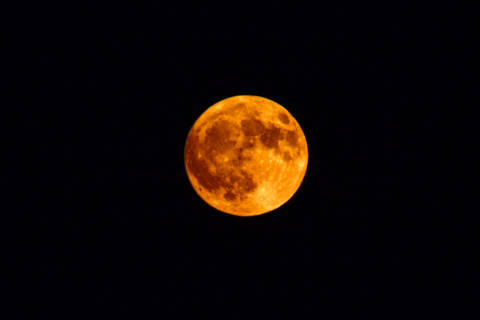WASHINGTON — Got plans Sunday night, Monday morning? Whatever they are and wherever you are, your plans should include taking a peek at the moon.
Depending on when you were born, doing so may be a once-in-a-lifetime event as November’s full moon will be the closest one since Jan. 26, 1948, and it will not be this close again until Nov. 25, 2034.
November’s full moon will also be a “supermoon,” a phrase that has become part of our popular culture in recent years but has been around since 1979. In each monthly lunar cycle, while orbiting the earth, our moon has a point where it is closest to the earth — called perigee — and when it is farthest — apogee. When the full moon occurs the same day as perigee, that is when it is a supermoon. This can occur several times a year. In fact, we are in a stretch of three supermoons in a row that ends with December’s full moon.
The closest the moon can get to earth is 221,500 miles, and November’s supermoon will be 221,524 miles from earth — so that is close! The actual moment when the moon is closest will be Monday morning at 6:23 a.m., just before the moon will be setting in the west at 6:36 a.m. in D.C. The moon is actually at full phase later in the morning at 8:52 a.m., so observers out west will be able to view the full moon at its closest.
Sunday night you will see a glorious nearly full moon rising in the east after sunset. You can find out when the moon rises and sets for your location here. For the D.C. area, moonrise is at 4:43 p.m. Sunday night.
To observe the moon Sunday night and Monday morning, try to find a horizon in the east and west that are clear of obstructions so you can see the moon near the horizon. The moon may have some color, and it may appear large due to the “moon illusion.” The supermoon is actually bigger than an average full moon, but it is hard to detect by eye. The supermoon will also be brighter, which may be apparent to observers.
November’s full moon is also known as the full “Beaver Moon.” If you want to photograph the “Full Beaver Supermoon,” see NASA’s tips here.
At 8 p.m. Saturday, I will be at Shenandoah National Park’s Skyland Conference Center talking about the moon. Afterward, if the sky is clear, we will enjoy views of the moon and night sky. I hope you can join me.
To me, the moon is always special, but Sunday night and Monday morning will be an event you can take part in that does not happen very often.
Follow me at Twitter @skyguyinva and my daily blog at www.whatsupthespaceplace.com to keep up with the latest news in astronomy and space exploration. You can email me at skyguyinva@gmail.com.







